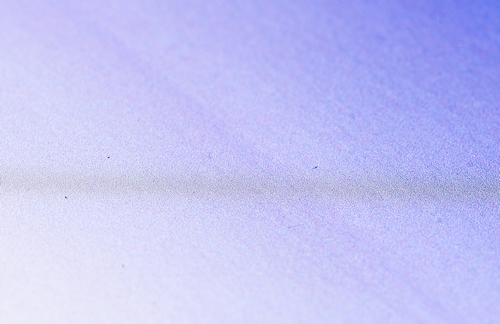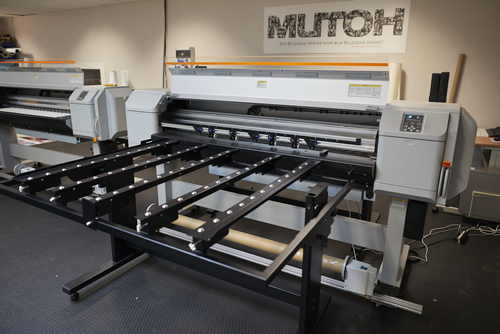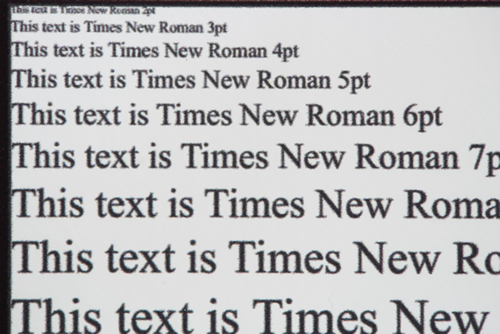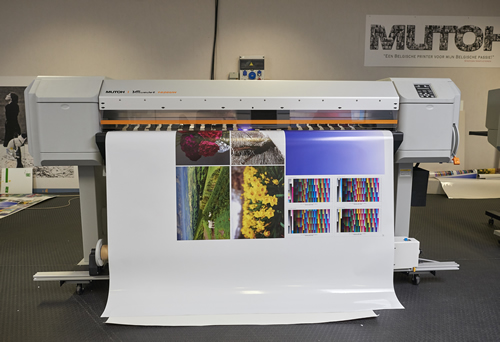Mutoh is targeting this entry-level LED UV printer at the quality end of the market, but how well does it do in our test? Nessan Cleary investigates.
The ValueJet 1626UH is a 1.6m wide UV hybrid printer, designed to produce high quality prints for entry level volume printers, as well as prototypes for packaging. It uses LED curing and so Mutoh has marketed it as a speciality and industrial printer, to distinguish it from its range of solvent printers, which are also called ValueJets. It takes a standard range of media, including vinyl, canvas and wallpaper, as well as most rigid media up to 15mm thick, and up to 15kg in weight.
The printer uses a single IA4450 printhead, which is based on the Epson DX7 head and uses eight channels, each of 180 nozzles. It’s a greyscale head and produces drop sizes from 3.8 to 28 picolitres. However, the drop sizes are arranged into three groups, each of three drops, with the selected print mode determining which group of drop sizes is used. Thus the fastest modes tend to use larger drop sizes, while the higher quality modes use the smaller drops to better reproduce fine details.
There’s a single LED array on the left side of the print shuttle, far enough from the heads to allow printing to mirrored surfaces without reflecting the light back to the head and curing the ink on the nozzles.
Using an LED means there’s no need to wait for the printer to warm up to temperature between jobs and it will handle heat sensitive materials. The LED should also keep power consumption to a minimum. Mutoh estimates that it will last for 14,250 hours.
Naturally, this printer incorporates the I2 Interweaving technique, developed at Mutoh Europe. It’s been updated for LED inks. Commercial marketing manager Nick Decock explains: “You can suffer from irregular banding but also gloss banding from LED inks. So the engineers are tuning the wave forms according to the LED inks.”
Inks
There’s a choice between loading CMYK or CMYK plus white and varnish. Decock says that there’s no need to add light cyan or light magenta as the inks have a wide enough colour gamut and the additional colours would just increase the costs. The ink comes supplied in 220ml cassettes though there is also a bulk ink system that takes pouches up to 800ml and can reduce costs further.
Mutoh is using a fairly rigid UV ink. Decock explains: “You can still print to a canvas or vinyl. It has a degree of flex but not compared to a flexible ink.”
He says that the inks have good adhesion to a range of substrates, including some glass media. He adds: “We don't offer primers yet but by starting with yellow and then moving to CMK you can improve the ink adhesion. We might recommend primers or offer them but we are still testing them.”
Media alignment
The printer can automatically set the height of the print carriage by lowering a stick to work out the thickness of the media. The print carriage will also orientate itself when printing starts, normally by detecting the front of the media but it can be set to find the width of the media.
There’s also a simple but highly useful Media Alignment feature, which is basically just a set of bars at the front of the platen. However, it allows for very accurate registration, which is handy for double-sided printing or if you need to overprint an existing job.
Maintenance
Mutoh recommends cleaning the channels at the end of every working day, which is just a simple matter of wiping over the nozzles before switching it off. There is a cleaning station on the left side and you can reach up and into it to manually wipe around the heads. There is also a capping station on the right.
If you use white ink you can put it into a sleep mode and determine when it will do a cleaning cycle. So you could set it to do a normal cleaning cycle every 24 hours. The power light flashes every five seconds to warn you it’s asleep.
On test
For this test we visited Mutoh’s European HQ in Ostend, Belgium. The VJ-1626UH was loaded with four colours and set-up for roll-to-roll printing since we printed to a monomeric self-adhesive vinyl.
We ran our standard test, which consists of two A0-sized PDFs - one featuring mainly solid Pantones and one a variety of different photographs. We printed both charts out at a high quality setting, to gauge the best quality that the printer is capable of, and again using a typical production mode to get an idea of the sort of speeds you can expect for most day-to-day jobs.
For the quality mode we used 720 x 1440dpi, uni-directional, which took 25.39 minutes for the Pantone chart, and 23.39 minutes for the photographs chart. Next, we used the standard production mode of 720 x 720dpi, also uni-directional, which took 13.03 minutes for the Pantone chart and 12.02 minutes for the photographs. We used an Onyx Rip, but were unable to record the ink consumption, though Mutoh estimates it’s around 10ml per square metre.
We did encounter a distinct issue with keeping the media flat, which led to the printhead brushing against the media covering the nozzles in ink. This wasted a fair bit of media, not to mention time as we then had to run a nozzle clean and nozzle check. This cleaning took about six minutes. However, this did improve when we changed the media roll so it could simply be down to an individual roll.
All the prints appear quite pleasing with good colour rendition and few obvious artefacts. There is some slight gloss banding apparent on the Production mode photographic chart, but only noticeable from very close up, with the right lighting.
The graduation in the gradient blue panel is not quite as smooth as we would have liked, with a slight magenta cast and a distinct blue and magenta line across the lighter part of the panel. These problems have disappeared on the Quality mode.
Both modes have handled shadow detail well - the yellows are more saturated in the Quality mode - but otherwise there's very little difference between the two.
The solid Pantones reveal some banding in Production mode, though this isn't noticeable once you step back about half a metre. The black gradient is also noticeably smoother in the slower mode, as you would expect.
The text is just about legible down to 3pt in the production mode and is a little sharper in the Quality mode. Mutoh say that it should be better on rigid media and that was certainly borne out from the samples we saw in the demo room.
Conclusion
The printer costs £27,995, while the inks cost £59.99 for a 220ml cassette and £153.99 for the 800ml pouches. There’s a 200ml cassette of UV cleaning fluid for £54.99. In addition, Colourgen, which supplies the Mutoh printers in the UK, can offer an annual service contract.
There are optional tables available for rigid media, which cost £1795 each, with two required.
These tables come with three ruler bars, but it’s possible to add extra bars to support thinner materials.
There’s a choice of take-up systems, as Decock explains: “Our feeling is that the take up depends on your work. So if a customer wants to do roll-to-roll full time then we might need a heavier duty system.” The standard take-up is £900.
There’s no Rip included though Mutoh supplies media profiles for Onyx, Caldera and SAi, and Colourgen generally recommends the Caldera Rip, though most standard Rips should be suitable.
This is certainly not the fastest machine - I think Mutoh would benefit from adding a second printhead, as it does with some of its other models. Instead the main selling point is its image quality and here it performs quite well. It’s nearly twice as fast with just the four colours, but is possible to achieve some very nice effects with the white, which is handy for backlits and window graphics and can cope with up to three layers, as well as the varnish, which can flood coat an entire image or selectively pick out details. It does seem to be a little picky over the flexible media used but it's still hard to beat the image quality on a hybrid LED UV machine for this sort of cost.





